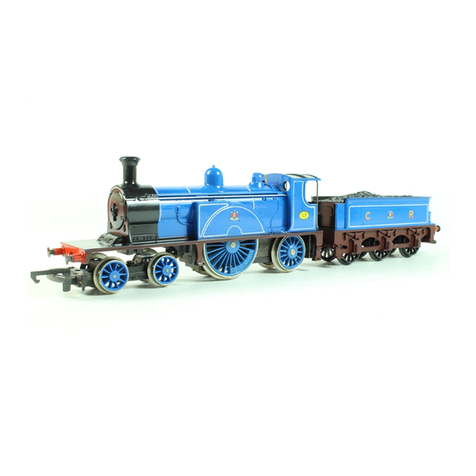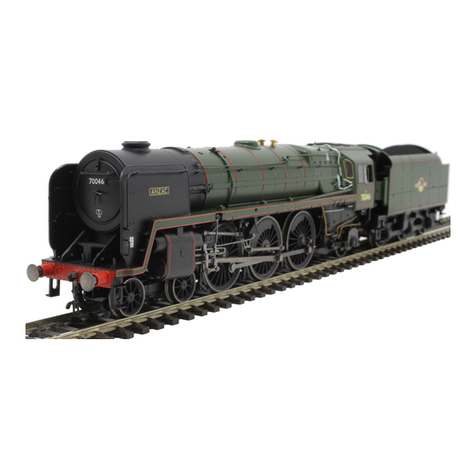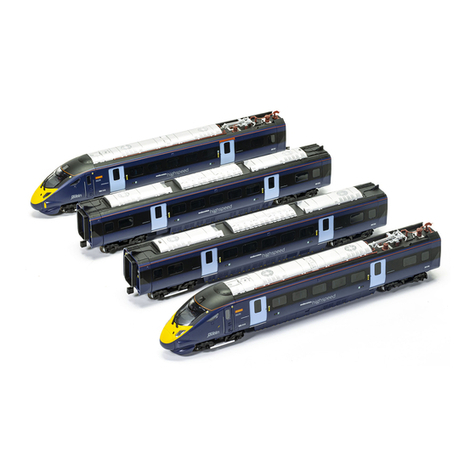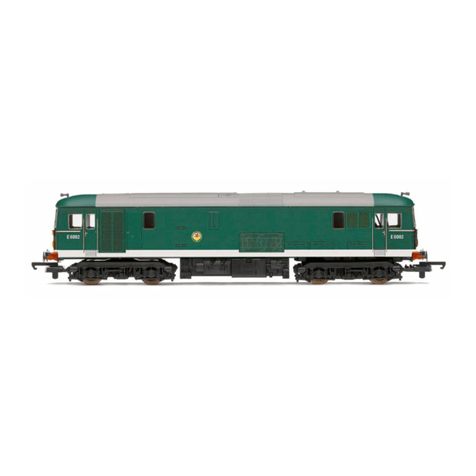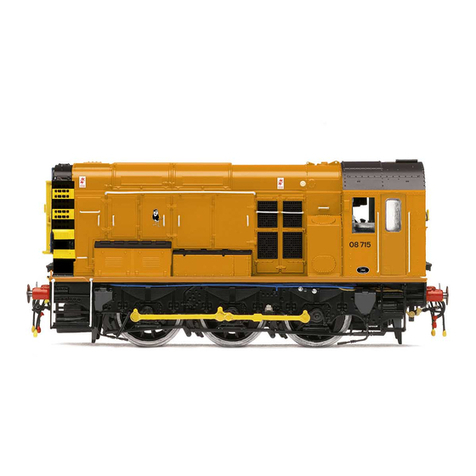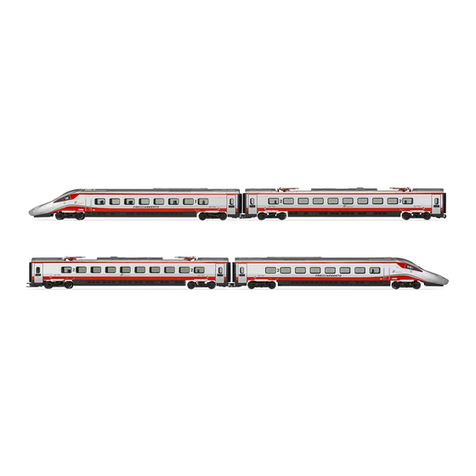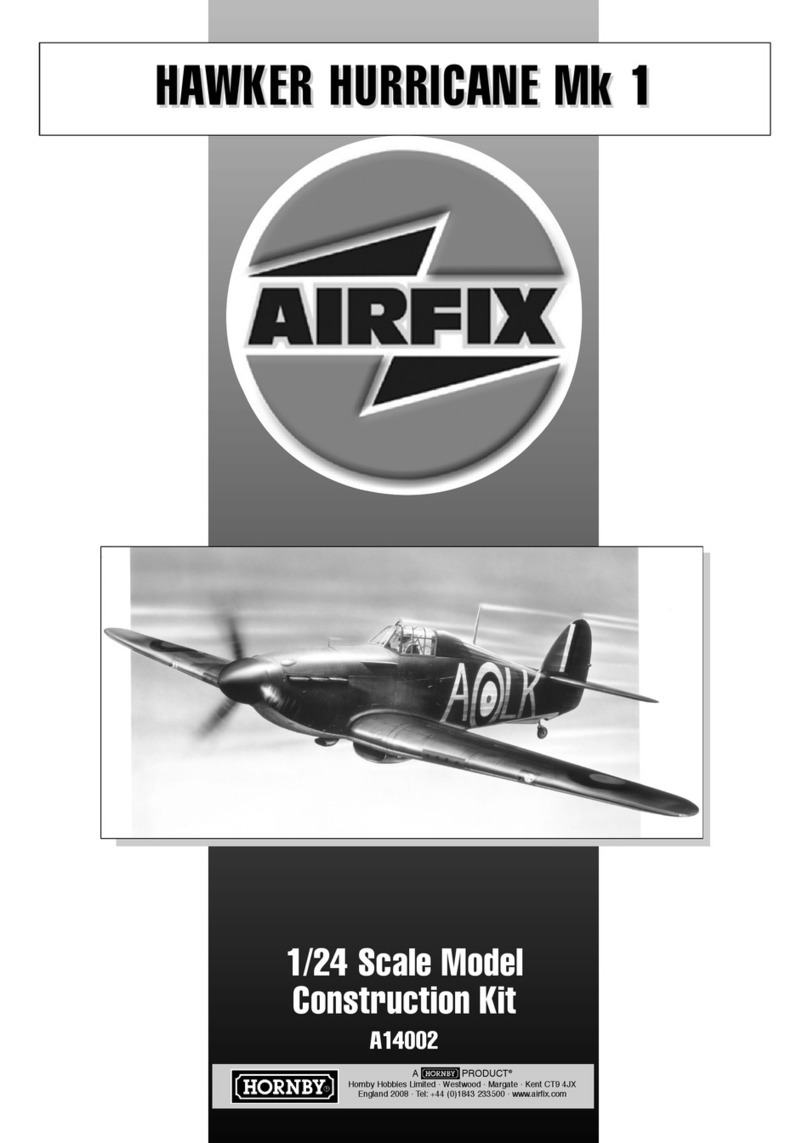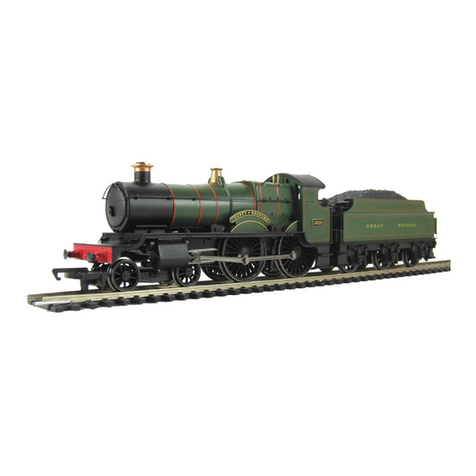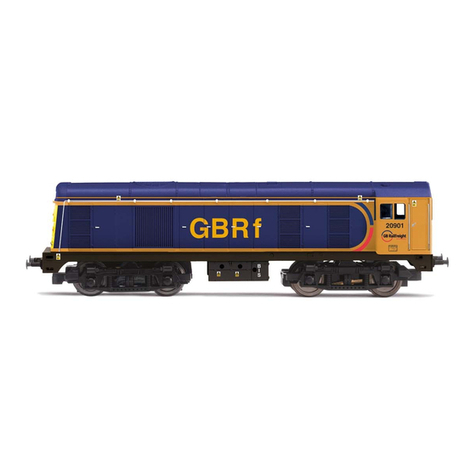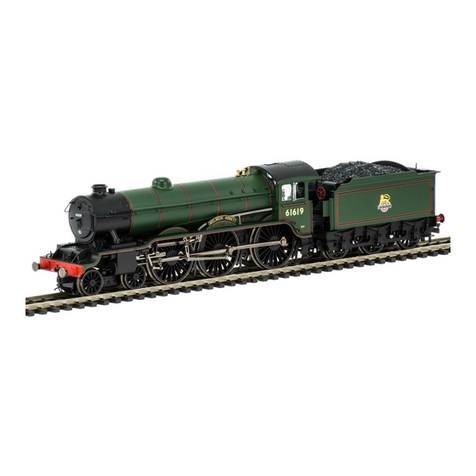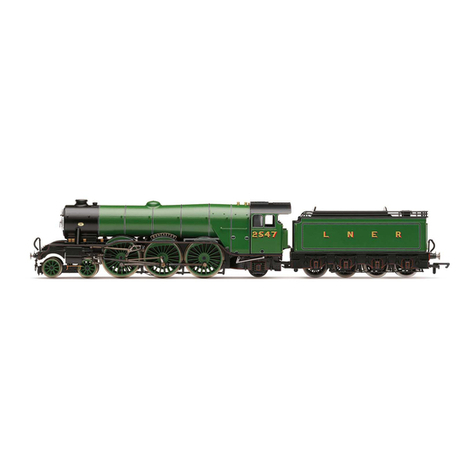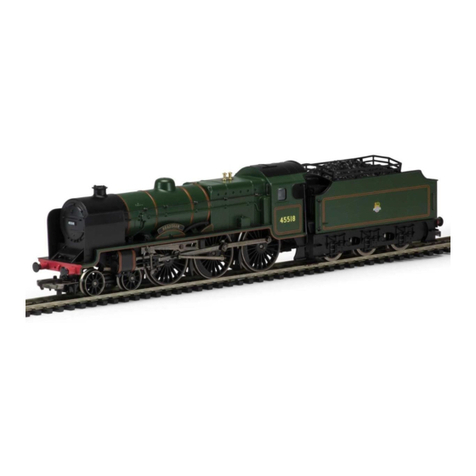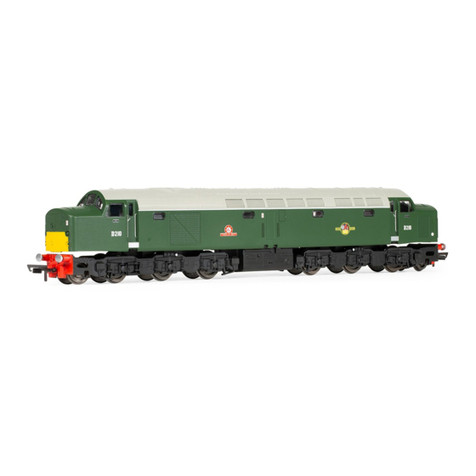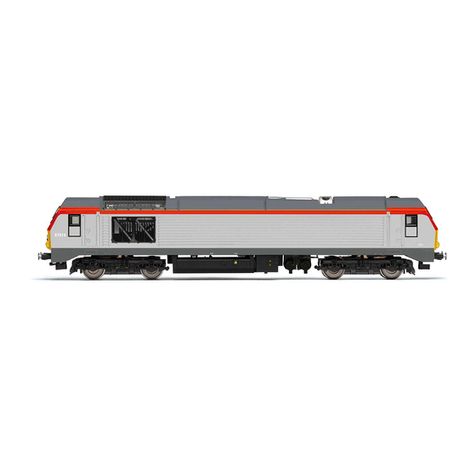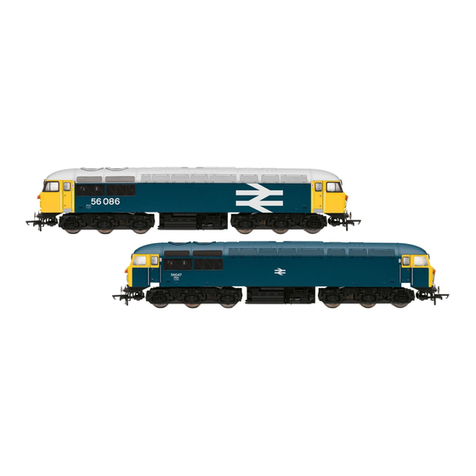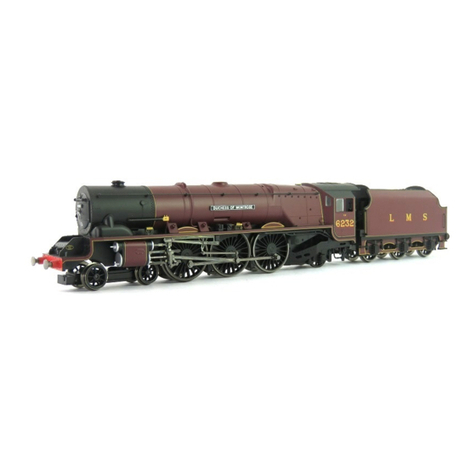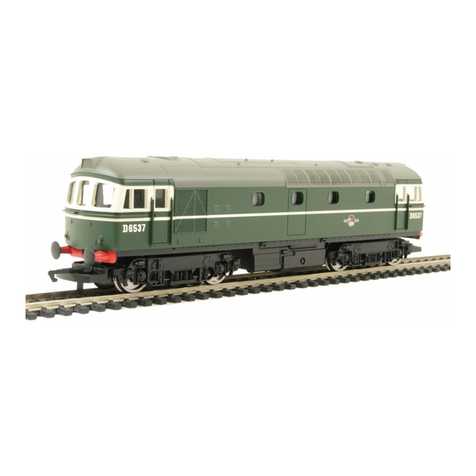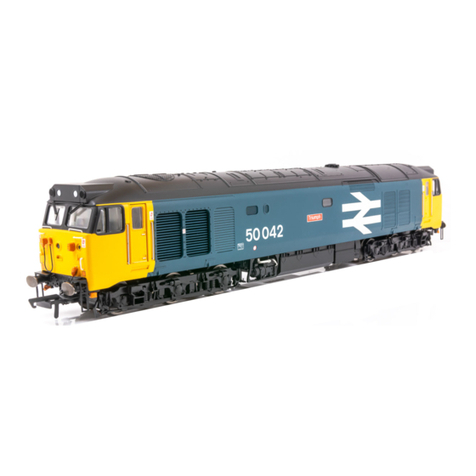
14
STANDARD CLASS 4
Operating and Maintenance Instructions
DCC Ready / DCC Fitted
4-6-0 Steam Locomotive and Tender
Routine Maintenance
Track Cleaning – In normal use, model railway layouts
will eventually accumulate a blackish deposit on the
running surfaces of the rails, and some of this will be
transferred onto the locomotive’s pick-up wheels.
The 12 volt DC supply is collected from the track
through the wheels on one side of the locomotive and
returned through the wheels on the other side. If the
deposit is allowed to build up, it will have the following
adverse effects:
• The driving wheels will not be able to achieve
maximum traction
• There will be a reduction in the power reaching the
locomotive motor
It is therefore essential that the track, and wheels, are
kept clean. This can be done by wiping the surfaces with
a clean, non-fluffy cloth. More stubborn deposits can be
removed by using the Hornby Track Cleaning Rubber,
reference R8087, which can be obtained from Hornby
Service Dealers.
Motor – The locomotive is fitted with a sealed, long-
life, 5-pole motor which requires no maintenance.
After a considerable amount of use the motor may
require replacement and this should be carried out by a
Hornby Service Dealer.
Chassis – The locomotive chassis may, from time to
time, pick up fluff, fabric fibres and pet hairs which can
become entangled in the gears and around axles. For
this reason, it is not advisable to run the locomotive on
track which is laid on a carpet. It is important to check
regularly and remove any such debris with the aid of
small tweezers.
Lubrication – Although the locomotive was lubricated
during manufacture, the lubricant can sometimes dry
out in storage. Lubrication should be carried out at
approximately 6-monthly intervals, or every 100 hours
of running. Instructions for carrying out lubrication
procedures are given in section 1 on pages 2 and 3.
Locomotive Bodywork – The locomotive and tender
bodies are overall spray painted and the rest of the
decoration is applied by a printed process, not transfers.
Safety Notes
Television Suppression
Your Hornby locomotive incorporates radio and television interference suppressors. Should interference be
experienced despite these precautions, it may be due to close proximity of the model railway layout to receivers,
aerials, or their ‘downlines’. In this case, move the layout further away from aerials and receivers.
It is most important that track and wheels be kept absolutely clean.
Spare Parts and Service
Spare parts packs can be obtained from Hornby Service Dealers who are also able to offer a repair service.
• This locomotive is not suitable for children under
3 years of age because of small parts which can
present a choking hazard. Some components
have functional sharp points and edges –
handle with care.
• This locomotive is intended for indoor use only.
• The transformer is not a toy. It is a ‘Transformer
for Toys’. Before use, check that the transformer
is the correct voltage for your mains electricity
supply. This locomotive is only to be used with
the recommended transformer. The transformer
should be examined regularly for damage to the
casing, plug pins and cables.
In the event of such damage, the set should not
be used until the transformer is replaced with a
new Hornby recommended unit. Never attempt
to open the transformer yourself.
• This locomotive must not be connected to more than
the recommended number of power supplies. The out-
put terminals of the transformer must not be connected
directly, or indirectly, to the output of any other AC
circuit derived from a transformer or mains power supply.
• Before cleaning any part, disconnect the transformer
from the mains electricity supply.
Do not use liquid for cleaning.
• Please retain these details and address for future
reference.
Waste electrical products should not
be disposed of with household waste.
Please recycle where facilities exist.
Check with your Local Authority or
retailer for advice
Brake Rods
7
Before fitting the locomotive
brake rods, you must
remove the transit brackets
illustrated, by loosening the
retaining screws, removing
the brackets and then
retightening the screws.
(See Fig.14)
Fig.15
Fig.14
IMPORTANT
• The protective 2-part polystyrene pack is designed to prevent damage during
product removal. Remove the bands found at either end of the pack. Lift off the
upper half of the pack, exposing the locomotive for easy access. Remove transit
• This locomotive is made to exacting fine scale standards and therefore
necessarily incorporates small, delicate, protruding parts – handle with care.
• Before using the model, read through the Operating and Maintenance
Instructions in this leaflet.
Hornby Hobbies Limited Margate Kent CT9 4JX UK Tel: +44 (0)1843 233525 www.hornby.com
Printed in China
4/1345
A Hornby product
General
Please read right through these instructions,
particularly the Safety Notes on page 4.
Hornby locomotives are precision built and, if treated
with care, will give many years of good service.
Care should be taken to avoid damage when handling
the model.
This locomotive should not be operated on track
curves of less than 438mm radius, which is Hornby
2nd radius track.
The five-pole electric motor of the locomotive is
designed to be operated from a variable 12 volts,
DC power supply only. This should be obtained by using
a suitable Power Controller operated from the normal
domestic mains electricity supply.
NEVER CONNECT A LOCOMOTIVE DIRECTLY
TO THE MAINS ELECTRICITY SUPPLY.
The locomotive will normally draw a current of between
·2 and ·4 amp depending upon the track configuration
and whether or not gradients are included. There will
be a current surge on starting the locomotive.
Running Hints
If a locomotive ceases to respond normally to the power
DCC Ready
Contact your specialist dealer for advice.
controller, or runs badly, check that the following are in
order:
• All electrical connections are correctly made and the
wall power socket is switched ‘ON’.
• The power connecting clip is correctly inserted into a
suitable section of track.
• All track sections are correctly fitted together and
all fishplates (rail-joiners) are fitting tightly onto
adjoining metal rails.
• All locomotive wheels are correctly positioned on the
track rails.
• The direction control switch on the train controller is
set to operate in one direction or the other, and not
in the central ‘OFF’ position.
brackets from the product where fitted.
